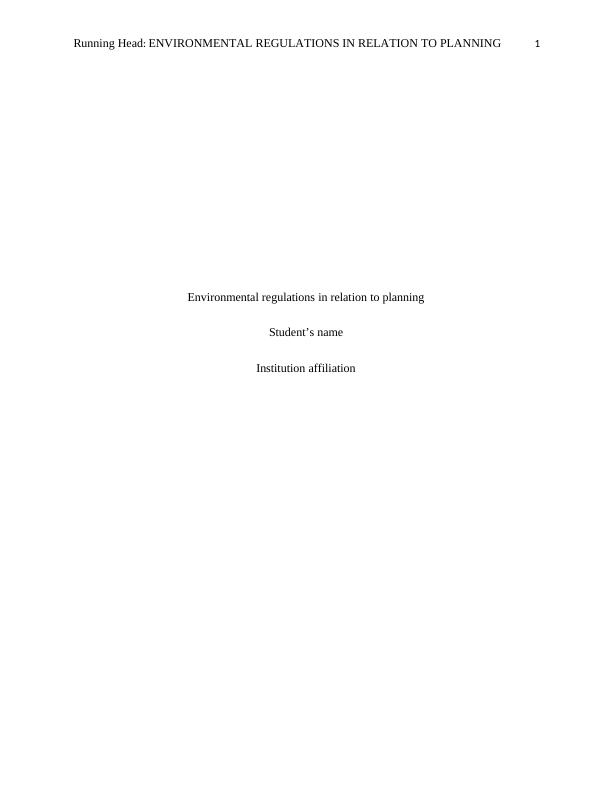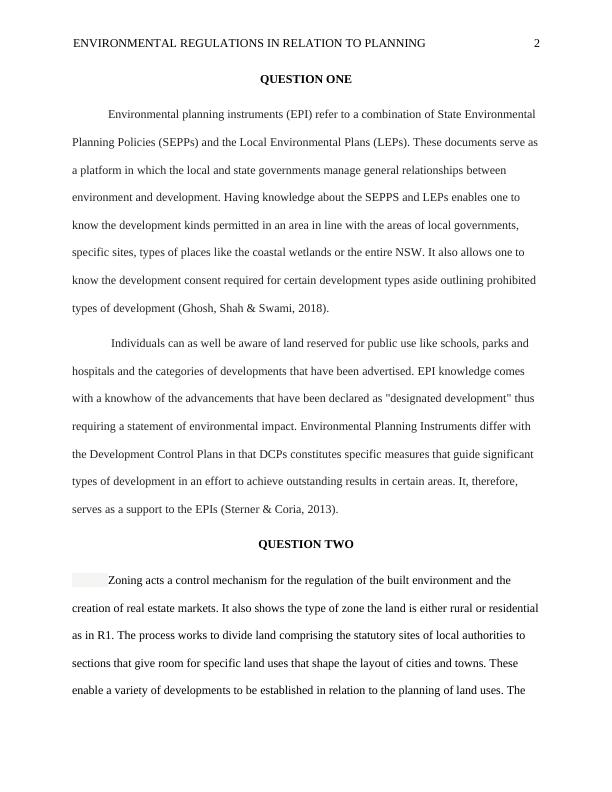Environmental Regulations in Relation to Planning
Added on 2023-01-23
7 Pages1522 Words37 Views
Running Head: ENVIRONMENTAL REGULATIONS IN RELATION TO PLANNING 1
Environmental regulations in relation to planning
Student’s name
Institution affiliation
Environmental regulations in relation to planning
Student’s name
Institution affiliation

ENVIRONMENTAL REGULATIONS IN RELATION TO PLANNING 2
QUESTION ONE
Environmental planning instruments (EPI) refer to a combination of State Environmental
Planning Policies (SEPPs) and the Local Environmental Plans (LEPs). These documents serve as
a platform in which the local and state governments manage general relationships between
environment and development. Having knowledge about the SEPPS and LEPs enables one to
know the development kinds permitted in an area in line with the areas of local governments,
specific sites, types of places like the coastal wetlands or the entire NSW. It also allows one to
know the development consent required for certain development types aside outlining prohibited
types of development (Ghosh, Shah & Swami, 2018).
Individuals can as well be aware of land reserved for public use like schools, parks and
hospitals and the categories of developments that have been advertised. EPI knowledge comes
with a knowhow of the advancements that have been declared as "designated development" thus
requiring a statement of environmental impact. Environmental Planning Instruments differ with
the Development Control Plans in that DCPs constitutes specific measures that guide significant
types of development in an effort to achieve outstanding results in certain areas. It, therefore,
serves as a support to the EPIs (Sterner & Coria, 2013).
QUESTION TWO
Zoning acts a control mechanism for the regulation of the built environment and the
creation of real estate markets. It also shows the type of zone the land is either rural or residential
as in R1. The process works to divide land comprising the statutory sites of local authorities to
sections that give room for specific land uses that shape the layout of cities and towns. These
enable a variety of developments to be established in relation to the planning of land uses. The
QUESTION ONE
Environmental planning instruments (EPI) refer to a combination of State Environmental
Planning Policies (SEPPs) and the Local Environmental Plans (LEPs). These documents serve as
a platform in which the local and state governments manage general relationships between
environment and development. Having knowledge about the SEPPS and LEPs enables one to
know the development kinds permitted in an area in line with the areas of local governments,
specific sites, types of places like the coastal wetlands or the entire NSW. It also allows one to
know the development consent required for certain development types aside outlining prohibited
types of development (Ghosh, Shah & Swami, 2018).
Individuals can as well be aware of land reserved for public use like schools, parks and
hospitals and the categories of developments that have been advertised. EPI knowledge comes
with a knowhow of the advancements that have been declared as "designated development" thus
requiring a statement of environmental impact. Environmental Planning Instruments differ with
the Development Control Plans in that DCPs constitutes specific measures that guide significant
types of development in an effort to achieve outstanding results in certain areas. It, therefore,
serves as a support to the EPIs (Sterner & Coria, 2013).
QUESTION TWO
Zoning acts a control mechanism for the regulation of the built environment and the
creation of real estate markets. It also shows the type of zone the land is either rural or residential
as in R1. The process works to divide land comprising the statutory sites of local authorities to
sections that give room for specific land uses that shape the layout of cities and towns. These
enable a variety of developments to be established in relation to the planning of land uses. The

ENVIRONMENTAL REGULATIONS IN RELATION TO PLANNING 3
land zones like R1 determine the size, location use of buildings as well as the city block's
density. The regulations of zoning are created in the form of ordinances. In most cases, they are
texts that specify the use of land in distinct blocks extended to individual sites within the city's
block. The regulations are specific to the floor area ratio (FAR), height, bulk and the size of the
lot (Awasthi, Adetiloye & Crainic, 2016).
The zoning ordinances serve to formally categorize the policies for land-use applicable to
municipality land aside from setting a legal framework. It develops land uses that are acceptable
and compares them with different uses of land in a quest to avoid incompatible lands being
located at close proximity with each other. This is associated with defined setbacks which in turn
builds the safety and resilience of the city by setting restrictions on constructions in wetlands and
floodplains. The principal Development Standards in LEP are the blueprints of the content in EPI
in line with whether certain provisions are optional or compulsory during the adoption of the
planning instruments (Bronfin, Kay, Gemora, Tou, Butts, McGee & Pease, 2015).
QUESTION THREE
A complying development refers to a combined construction and planning development
approval that attains the standards pre-determined for developments. An assessment that is
usually code-based is crucial in the determination of Complying Development Certificate (CDC).
An exempt development accounts for the minor work types that require no planning application
or approval for constructions hence they cannot be assessed by the council.
Knowing whether development is exempt or complying, calls for planning certificate
issuance by the council in NSW under the codes set aside by SEPP. These codes usually aim at
the removal of unnecessary complexities and homered tapes. This acts as the easiest way to
land zones like R1 determine the size, location use of buildings as well as the city block's
density. The regulations of zoning are created in the form of ordinances. In most cases, they are
texts that specify the use of land in distinct blocks extended to individual sites within the city's
block. The regulations are specific to the floor area ratio (FAR), height, bulk and the size of the
lot (Awasthi, Adetiloye & Crainic, 2016).
The zoning ordinances serve to formally categorize the policies for land-use applicable to
municipality land aside from setting a legal framework. It develops land uses that are acceptable
and compares them with different uses of land in a quest to avoid incompatible lands being
located at close proximity with each other. This is associated with defined setbacks which in turn
builds the safety and resilience of the city by setting restrictions on constructions in wetlands and
floodplains. The principal Development Standards in LEP are the blueprints of the content in EPI
in line with whether certain provisions are optional or compulsory during the adoption of the
planning instruments (Bronfin, Kay, Gemora, Tou, Butts, McGee & Pease, 2015).
QUESTION THREE
A complying development refers to a combined construction and planning development
approval that attains the standards pre-determined for developments. An assessment that is
usually code-based is crucial in the determination of Complying Development Certificate (CDC).
An exempt development accounts for the minor work types that require no planning application
or approval for constructions hence they cannot be assessed by the council.
Knowing whether development is exempt or complying, calls for planning certificate
issuance by the council in NSW under the codes set aside by SEPP. These codes usually aim at
the removal of unnecessary complexities and homered tapes. This acts as the easiest way to

End of preview
Want to access all the pages? Upload your documents or become a member.
Related Documents
Planning And Developmentlg...
|7
|1392
|64
Construction: Council and Site Constraints for Strategic Planninglg...
|12
|2666
|95
Strategy for planning requirements PDFlg...
|7
|1629
|92
Planning and Environmentlg...
|6
|1543
|31
Assessment Report - Single Storey Dwellinglg...
|10
|2794
|92
Assessment Report - Single Storey Dwellinglg...
|9
|2641
|45
